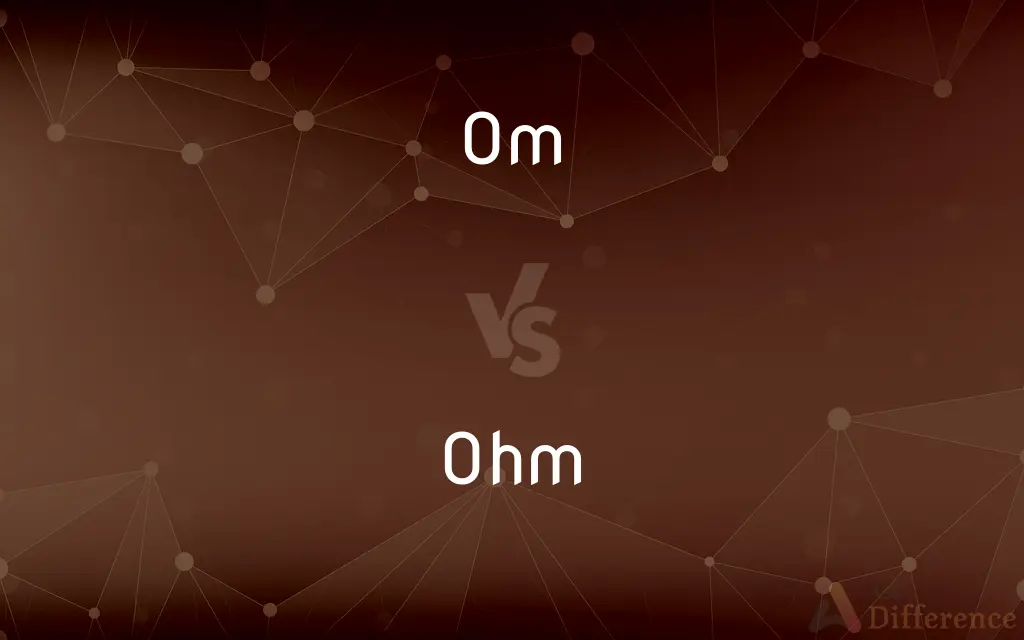Om vs. Ohm — What's the Difference?
By Tayyaba Rehman & Urooj Arif — Updated on April 4, 2024
Om refers to a sacred sound and spiritual icon in Hinduism, symbolizing the essence of the universe. Ohm is a unit of electrical resistance, indicating how strongly a material opposes the flow of electric current.

Difference Between Om and Ohm
Table of Contents
ADVERTISEMENT
Key Differences
Om, often spelled Aum, is a sacred syllable in Hinduism, Buddhism, and other Dharmic religions, representing the universe's spiritual and material aspects. It is considered the sound of the cosmos, signifying the essence of ultimate reality or consciousness. On the other hand, Ohm is a scientific term, named after Georg Simon Ohm, a German physicist known for formulating Ohm's law. This law relates voltage (potential difference), current, and resistance in electrical circuits, where one ohm is the resistance between two points of a conductor when a potential difference of one volt applied between them produces a current of one ampere.
Om is integral to meditation and prayers in various Eastern religions, often chanted at the beginning and end of sessions, embodying peace and spiritual power. Whereas, Ohm is a practical unit used in physics and engineering to measure how difficult it is for electricity to flow through a conductor. It's essential in designing and understanding electrical circuits, components, and systems.
The significance of Om lies in its spiritual and philosophical implications, symbolizing a connection to the divine and the interconnectivity of all beings. Conversely, the importance of Ohm lies in its application to the physical world, particularly in electricity and electronics, affecting everything from household appliances to complex electronic systems.
While Om transcends the material world, aiming to connect individuals to a higher reality and consciousness, Ohm operates within the realm of the physical, governed by the laws of physics. The use of Om in religious and meditative practices is meant to deepen one's spiritual understanding, whereas the application of Ohm is critical in the practical, empirical understanding and manipulation of electric currents.
Despite their entirely different contexts—Om in spirituality and Ohm in science—both terms highlight the human endeavor to understand and interact with the world, whether through spiritual enlightenment or technological and scientific advancement.
ADVERTISEMENT
Comparison Chart
Definition
A sacred syllable symbolizing the essence of the universe.
A unit of electrical resistance.
Origin
Hinduism, Buddhism, and other Dharmic religions.
Named after Georg Simon Ohm, a 19th-century German physicist.
Context
Spiritual and religious.
Scientific, specifically in physics and electrical engineering.
Significance
Represents ultimate reality, consciousness.
Measures how strongly a material opposes the flow of current.
Application
Used in meditation, prayers, and spiritual practices.
Used in designing and understanding electrical circuits.
Compare with Definitions
Om
Symbolizes the universe's spiritual essence.
The Om symbol is often worn as a pendant to keep one connected to the divine.
Ohm
Essential in electronic device functionality.
The ohm values of components determine a device's power usage and efficiency.
Om
Represents unity with the cosmos.
The festival celebrated the harmony of life, symbolized by Om.
Ohm
Used in physics and engineering.
Understanding Ohm's law is fundamental to electrical circuit design.
Om
A sacred sound in Eastern religions.
The yoga class started and ended with the chanting of Om.
Ohm
Measured with an ohmmeter.
To fix the appliance, they measured the resistance in ohms of each component.
Om
Used in meditation to achieve higher consciousness.
He found peace and clarity meditating on the sound of Om.
Ohm
A unit for measuring electrical resistance.
The resistor has a value of 10,000 ohms.
Om
A mantra in Hindu rituals.
The priest chanted Om to invoke the presence of the divine.
Ohm
Indicates material's opposition to current flow.
Copper has a lower ohm value compared to rubber, making it a better conductor.
Om
Ōṁ (or Aum) (listen ; Sanskrit: ॐ, ओम्, romanized: Ōṁ) is the sound of a sacred spiritual symbol in Indic religions. The meaning and connotations of Om vary between the diverse schools within and across the various traditions.
Ohm
The ohm (symbol: Ω) is the SI derived unit of electrical resistance, named after German physicist Georg Ohm. Various empirically derived standard units for electrical resistance were developed in connection with early telegraphy practice, and the British Association for the Advancement of Science proposed a unit derived from existing units of mass, length and time, and of a convenient scale for practical work as early as 1861.
Om
The supreme and most sacred syllable, consisting in Sanskrit of the three sounds (a), (u), and (m), representing various fundamental triads and believed to be the spoken essence of the universe. It is uttered as a mantra and in affirmations and blessings.
Ohm
The SI unit of electrical resistance, transmitting a current of one ampere when subjected to a potential difference of one volt.
Om
A sacred, mystical syllable used in prayer and meditation.
Ohm
The SI unit of electrical resistance, equal to the resistance of a conductor through which a current of one ampere flows given a one-volt potential across the conductor. See Table at measurement.
Om
(intransitive) To chant the sacred syllable om.
Ohm
In the International System of Units, the derived unit of electrical resistance; the electrical resistance of a device across which a potential difference of one volt causes a current of one ampere. Symbol: Ω
Om
(colloquial) nom
Ohm
The standard unit in the measure of electrical resistance, being the resistance of a circuit in which a potential difference of one volt produces a current of one ampére. As defined by the International Electrical Congress in 1893, and by United States Statute, it is a resistance substantially equal to 109 units of resistance of the C. G. S. system of electro-magnetic units, and is represented by the resistance offered to an unvarying electric current by a column of mercury at the temperature of melting ice 14.4521 grams in mass, of a constant cross-sectional area, and of the length of 106.3 centimeters. As thus defined it is called the international ohm.
Om
A mystic syllable or ejaculation used by Hindus and Buddhists in religious rites, - orig. among the Hindus an exclamation of assent, like Amen, then an invocation, and later a symbol of the trinity formed by Vishnu, Siva, and Brahma.
Ohm
A unit of electrical resistance equal to the resistance between two points on a conductor when a potential difference of one volt between them produces a current of one ampere
Ohm
German physicist who formulated Ohm's Law (1787-1854)
Common Curiosities
Is Om only important in Hinduism?
No, Om holds significance in various Eastern religions, including Buddhism and Jainism, often used in spiritual practices to represent universal truths.
How is electrical resistance measured?
Electrical resistance is measured in ohms using an instrument called an ohmmeter, which applies a voltage to a resistor and measures the resulting current.
Can Ohm's law be applied to non-electrical contexts?
While Ohm's law is specific to electrical circuits, its principles of proportional relationships can be conceptually applied to other fields, such as fluid dynamics, in understanding resistance-like phenomena.
What happens if a material has zero ohms of resistance?
A material with zero ohms of resistance is considered a perfect conductor, allowing electric current to flow without any opposition. In practice, superconductors come closest to this ideal at very low temperatures.
How did Georg Simon Ohm discover Ohm's law?
Georg Simon Ohm discovered Ohm's law through experiments that measured the voltage and current in electrical circuits, finding a proportional relationship that led to the formulation of Ohm's law.
Can chanting Om impact physical health?
Yes, studies suggest that chanting Om can have a calming effect, reducing stress and potentially improving mental health and relaxation.
Why is Om often chanted at the beginning of yoga classes?
Om is chanted to mark the beginning of yoga classes as it helps unify the group, create a serene environment, and connect participants to their spiritual practice.
How is the Om sound produced?
The Om sound is produced by vocalizing the letters A-U-M, which merge into a continuous vibration, symbolizing the universe's energy.
Can the resistance measured in ohms change over time?
Yes, the resistance of a material can change with temperature, age, or physical condition, affecting how it opposes current flow.
Can Ohm's law be used for complex circuits?
Yes, Ohm's law can be applied to both simple and complex circuits, although complex circuits may require additional rules and principles for analysis.
Is there a symbol for Om?
Yes, Om has a distinct symbol in Sanskrit, which is widely recognized and used in art, jewelry, and decorations, often symbolizing spirituality and peace.
What is the importance of high or low ohm values in electronics?
High ohm values indicate greater resistance, used for reducing current flow in circuits. Low ohm values indicate less resistance, important for conductive paths in electronic devices.
Is Om considered a universal sound?
In the spiritual context, Om is considered a universal sound, symbolizing the foundation of all sounds and the essence of the universe.
Are there materials with negative ohms of resistance?
In conventional materials, negative resistance is not observed. However, certain electronic components, like tunnel diodes, exhibit negative differential resistance under specific conditions, used in oscillators and amplifiers.
Share Your Discovery

Previous Comparison
Soul vs. Psyche
Next Comparison
Destroy vs. DestructionAuthor Spotlight
Written by
Tayyaba RehmanTayyaba Rehman is a distinguished writer, currently serving as a primary contributor to askdifference.com. As a researcher in semantics and etymology, Tayyaba's passion for the complexity of languages and their distinctions has found a perfect home on the platform. Tayyaba delves into the intricacies of language, distinguishing between commonly confused words and phrases, thereby providing clarity for readers worldwide.
Co-written by
Urooj ArifUrooj is a skilled content writer at Ask Difference, known for her exceptional ability to simplify complex topics into engaging and informative content. With a passion for research and a flair for clear, concise writing, she consistently delivers articles that resonate with our diverse audience.













































